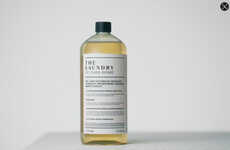
This Microplastic Filter Technology Captures Clothing Fibers
Michael Hemsworth — December 12, 2019 — Eco
References: shinshu-u.ac.jp & newatlas
A large portion of our clothing is created with synthetic material that sheds as it's laundered and contributes to water pollution, so this new microplastic filter technology is intended to help prevent this from occurring.
The filter was developed by a team of researchers at the Shinshu University in Japan and utilizes bulk acoustic wave (BAW) technology in order to use sound waves instead of physical filters. This will work to treat wastewater as it's expelled from a washing machine, and diverts microplastic waste in one direction and gray water down the drain.
The microplastic filter technology is reported to capture 95% of PET fibers as well as 99% of Nylon 6 fibers, but will need to be further refined to increase the filtering speed before it can go into production.
Image Credit: EdZbarzhyvetsky/Depositphotos
The filter was developed by a team of researchers at the Shinshu University in Japan and utilizes bulk acoustic wave (BAW) technology in order to use sound waves instead of physical filters. This will work to treat wastewater as it's expelled from a washing machine, and diverts microplastic waste in one direction and gray water down the drain.
The microplastic filter technology is reported to capture 95% of PET fibers as well as 99% of Nylon 6 fibers, but will need to be further refined to increase the filtering speed before it can go into production.
Image Credit: EdZbarzhyvetsky/Depositphotos
Trend Themes
1. Microplastic Filtration - This trend focuses on developing innovative technologies to effectively capture microplastic waste and prevent water pollution.
2. Sound Wave Utilization - This trend explores the use of sound waves as a replacement for physical filters in various applications, offering potential for more efficient and eco-friendly solutions.
3. Sustainable Textile Innovations - This trend highlights the development of materials and processes that reduce the environmental impact of clothing manufacturing and usage.
Industry Implications
1. Wastewater Treatment - The wastewater treatment industry can benefit from adopting sound wave-powered plastic filters to effectively remove microplastic waste and protect water resources.
2. Textile Manufacturing - The textile industry can explore the use of more sustainable materials and develop innovative processes to minimize the shedding of microplastic fibers from clothing.
3. Consumer Appliances - The consumer appliance industry can integrate sound wave-based filtration systems into washing machines to provide consumers with eco-friendly options that minimize microplastic pollution.
5.1
Score
Popularity
Activity
Freshness























